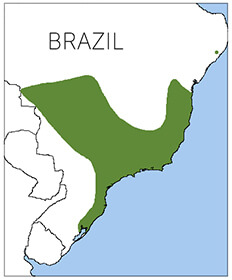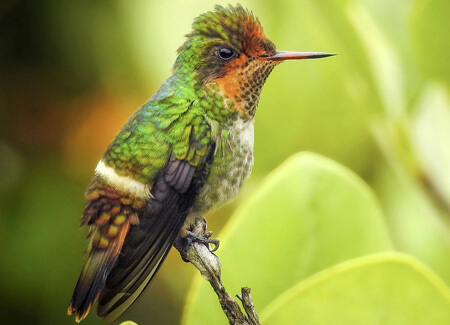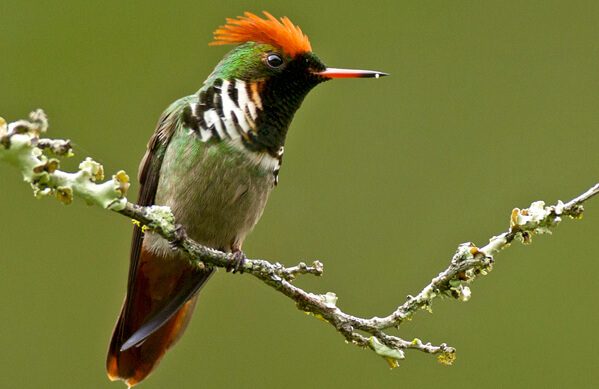 A “coquette” means a flirt, and to many birders, this species is indeed a tease. These small hummingbirds of Central and South America appear only infrequently at feeders and stay for only seconds at a time.
A “coquette” means a flirt, and to many birders, this species is indeed a tease. These small hummingbirds of Central and South America appear only infrequently at feeders and stay for only seconds at a time.
The species' genus name, “lophos,” derives from the Greek word meaning crest or tuft. It refers to the male's long orange crest, which he can raise and lower depending on his mood.
Like other birds found only in Brazil's Atlantic Forest, such as the Stresemann's Bristlefront, this bird is threatened by accelerating habitat loss.
Dashing Display
Less than three inches long, the Frilled Coquette is the smallest hummingbird in Brazil. The male is unmistakable with his orange crest, short red bill, and green-and-white, fan-shaped cheek feathers. Like many other female hummingbirds, his mate is comparatively plain and inconspicuous. Both sexes show a white band across the rump, a characteristic of the genus Lophornis.
Sign up for ABC's eNews to learn how you can help protect birds
In common with other hummingbirds, from the Ruby-topaz Hummingbird and Booted Racket-tail to the Ruby-throated, the Frilled Coquette feeds on small insects and nectar. This species will visit feeders but is not usually seen at them for long. The birds are so tiny that larger hummingbirds easily out-compete and drive them away.
In the mating season, which runs from August to March, the male pursues a female until she pauses. He then displays for her by erecting his crest, flashing his glittering emerald gorget, and fanning the black-and-white “frill” decorating the sides of his throat.

Frilled Coquette by Aisse Gaertner
Staying Out of Sight
Once she mates, the female coquette—like other hummingbird species—builds and tends her nest and young alone. Her tiny, cup-shaped nest is made of plants, moss, and bark, camouflaged with lichens and spider silk. She does her best to remain inconspicuous during this time, leaving her nest site when larger birds are nearby and returning only when they are gone.
Although non-migratory, the Frilled Coquette may make seasonal movements after the breeding and flowering seasons.
Stronghold at Serra do Urubu
The Frilled Coquette can be found in the Serra do Urubu reserve of northeastern Brazil, where ABC is working with in-country partner SAVE Brasil to conserve important Atlantic Forest habitat for the Frilled Coquette and other colorful endemic birds such as the Seven-colored Tanager.
ABC and SAVE Brasil are collaborating to buy two additional properties that will expand the reserve by 181 acres and improve connectivity among remaining forest fragments in the region. We have been pursuing a purchase for these areas for several years, and finally we have the chance to buy. Donate today and help us take advantage of this special opportunity and save Brazil's rarest birds. Or learn more about this effort to conserve more of the Serra do Urubu's unique forest.
Donate to support ABC's conservation mission!



















































